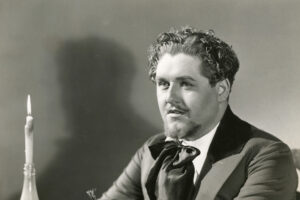

Paul Curran’s staging at John Jay College’s Gerald Lynch Theater places the works in modern sets (by the artist Georg Baselitz) in contrasting performance styles with similar satiric ends in view. The Baselitz sets perhaps imply we are inside an artistic installation in a stylish gallery.
Milhaud’s L’enlèvement d’Europe (The Rape of Europa) is one of the composer’s musical trilogy of spoofs on the seriousness of French classicism, none of them ten minutes long. It appears to be set at a vernissage in current Manhattan, and Court Watson’s costumes mimic such an occasion, mostly in black, Europa in red, Jupiter (an art patron perceived as a “white bull”) in hand-painted but shiny white. There is a “mooing” chorus as Jove (Daniel Montenegro, in high-flying Olympian phrases) elopes with the princess, who spurns the human suitor chosen by her father. Michael Mayes’ dark baritone was effective as the frustrated suitor, whose attacks bring retribution.

Though Montenegro had a happy moment climbing down the throne to be smitten by the “foreign princess,” this was largely a ladies’ opera: Helen Donath at her wits’ end as a Margaret Dumont-ish operatic queen, Jennifer Rivera using her impressively focused mezzo as a conniving Nurse, and Maeve Höglund singing her pea-shy, insomniac princess with soaring abandon.

Hindemith himself was not famous for his wit, but his Hin und Zurück (There and Back), the third opera, offers simpler meat to comic performers, and Curran has set it in a stiff, comic-book style that suits the material like a glove. A husband (Matthew Tuell) catches his wife (Höglund) with a note from her lover. He shoots her, medics remove the body, and he leaps from the window.
But “a wise man” (Montenegro, bewigged as Andy Warhol for some reason) appears to recommend “undoing” the damage—whereupon the entire score, four minutes to that point, is played in reverse, the suicide leaps back through the window, the medics return the body, she comes to life, the note is returned, the husband goes to work, peace is restored. Perhaps Hindemith had seen this sort of thing at the movies.

To keep the evening rolling along and spare us the agony of program notes, the singers provide ad lib “narrations” to introduce the pieces, explain the director’s “symbolism” and cover scene changes. This idea is not a great success, but it’s fun to watch a serene veteran like Donath working a crowd.
Perhaps the best part was the level of vocalism: No matter how blunt the harmonies or awkward the melodies or bewildering the action, the singing was of a rich, satisfying level, clarion, stylish, sensuous. Nothing went on very long (there wasn’t time), but no one sang under strain: All these composers knew voice and how to spin it to dramatic effect. Neal Goren led the various orchestral configurations brightly, guiding the little jests and pretty witticisms of the writing to our ears.
This eccentric mix of parodies, pointed or highbrow, brilliantly scored but melodically odd, make an elegant if scattershot entertainment. One wonders about the original audience: How musically sophisticated were they. Probably more than we are: They all learned instruments rather than listen to recordings. And how young were they? The avant-garde still had an establishment to fight against in those days.
The narration before Toch’s Prinzessin made much of the rise of Nazi anti-semitism and the Jewish Toch’s flight to America, but in fact three of the composers were Jews who fled here; only Hindemith, a Swiss and a gentile, did not. But 1927 was not a year of dark shadows: Germany was a prosperous republic at that time, open to new things, more or less untroubled. It took the Depression of the 1930s to bring the Nazis to power.
Photos: Richard Termine



























Comments